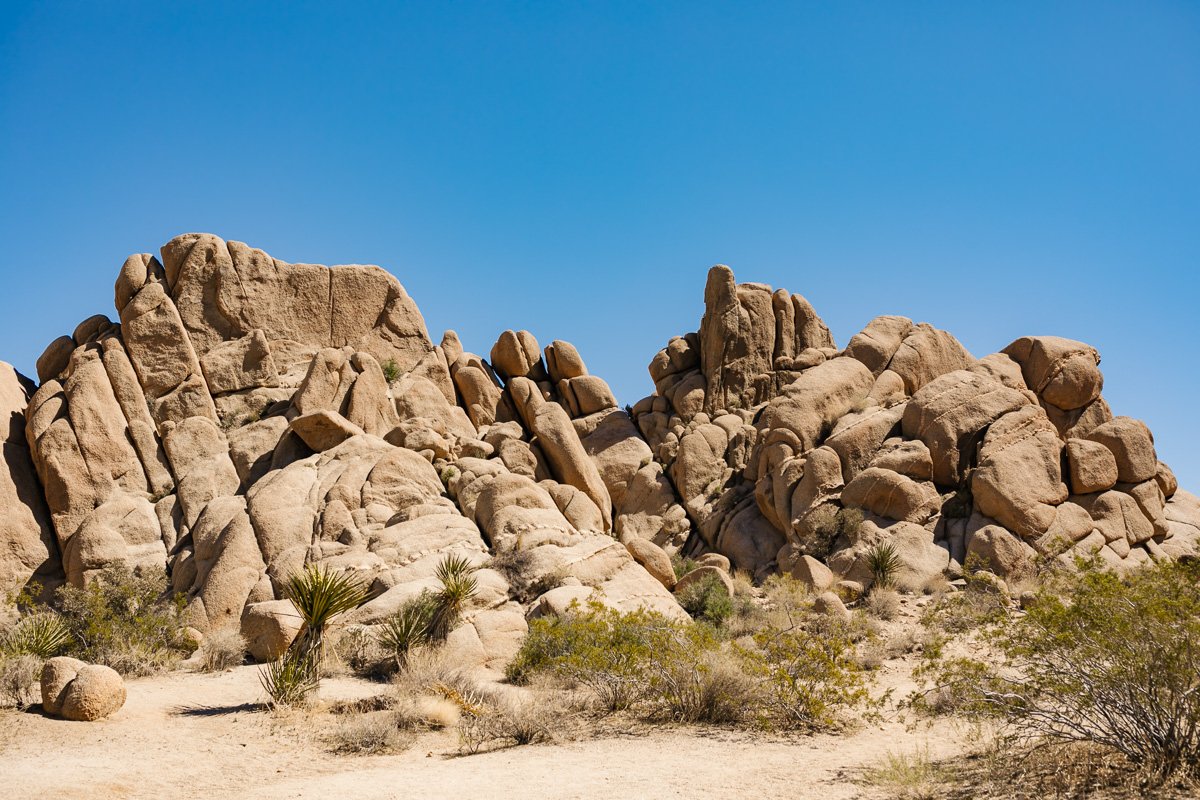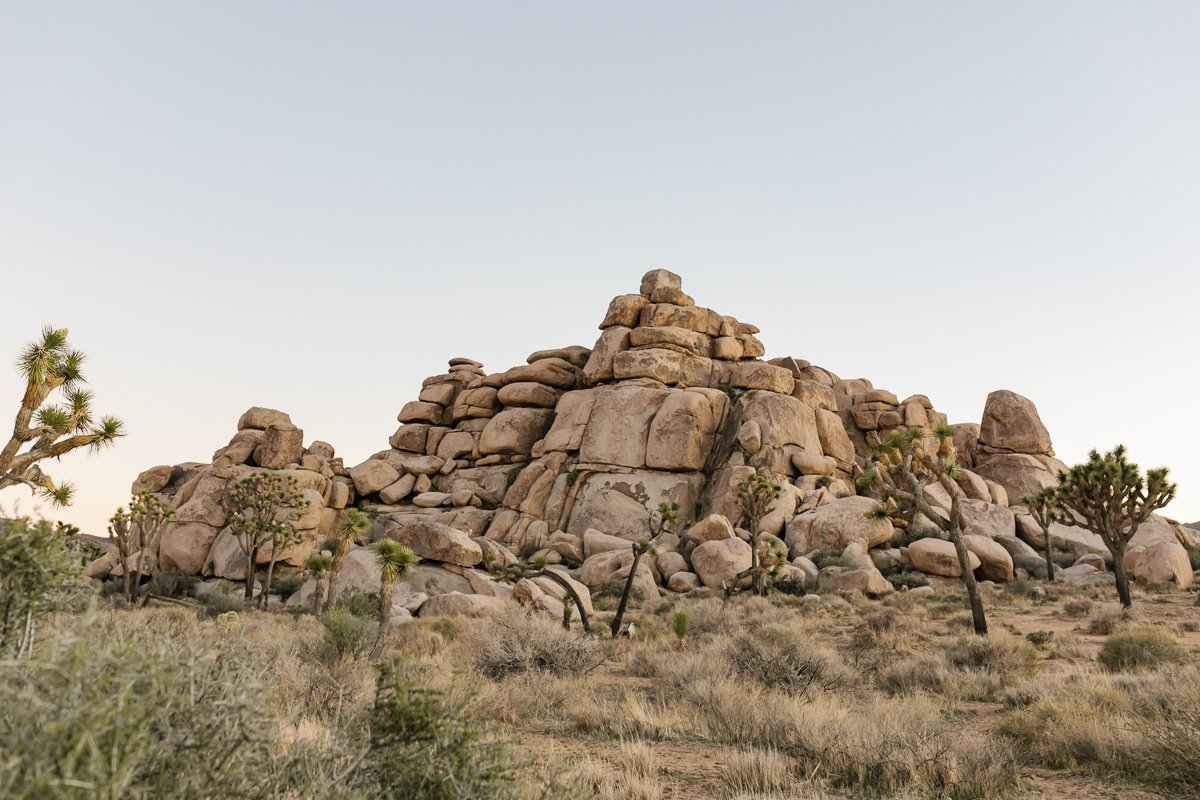Joshua Tree Elopement Guide
Welcome to your Joshua Tree elopement guide! In this guide, you’ll find everything you need to know for your Joshua Tree elopement, including:
The best elopement locations in the park — with photos and details for each spot
What to expect in terms of crowds and weather in every season
Tips for exploring the park
Sample elopement timelines
Important notes about permits and photography!
TOP 8 ELOPEMENT LOCATIONS IN JOSHUA TREE
1. Hidden Valley
2. Live Oak
3. Indian Cove Amphitheater
4. Quail Springs
5. Cap Rock
6. Queen Valley Mine Intersection
7. Rattlesnake
8. Split Rock
Joshua Tree Elopement Locations:
Hidden Valley
Hidden Valley Picnic Area is one of the more popular spots in the park, with the “parking lot full” sign often on display. And it’s popular for good reason: here you’ll find a lovely mix of Joshua trees and the iconic granite rocks happily hanging out together.
The good news is that while this is one of the busier areas, there are lots of smaller areas to explore and towards sunset the crowds thin quite a bit. Even though it can be busy, it’s easy to find an area all to yourselves with a few minutes of walking. There are also lots of rock outcroppings to give you a privacy screen.
Up to 35 people total, 8 vehicles.
Privacy + noise level: 3/5 (popular place to visit in the park, but if you come in the late afternoon + choose your spot strategically, you can avoid most of the people)
Iconic Joshua Tree look + feel: 5/5 (lots of Joshua trees + rock formations)
Overall feeling: 4/5 (iconic + beautiful)
2. Live Oak
Deeper into the park, you’ll find Live Oak Picnic Area. Live Oak is a pleasant surprise; it looks a bit unassuming as you pull up, but once you walk up and over the main outcropping of rock, the view to the south is a jaw dropper. Beautiful rock formations, you can see the mountains out in the distance, and very few people in sight.
Note: This area is close to Skull Rock (one of the most popular destinations in the park) so there can be some residual traffic.
Up to 5 people total, 3 vehicles.
Privacy + noise level: 5/5 (removed just enough from the main road to be peaceful, a little walking and you’ll be by yourselves)
Iconic Joshua Tree look: 4/5 (fewer Joshua Trees in this area, but the rocks are gorgeous)
Overall feeling: 4/5 (my favorite for a “just us” elopement)
3. Indian Cove Amphitheater
Tucked away in a remote part of the park is Indian Cove Amphitheater. Indian Cove is the only place in the park where you can get married with up to 100 people. It’s also not on the main road through the park so it’s much quieter than many of the places on this list. That also means it’s farther from some of the park’s highlights.
Up to 100 people total, shuttle required, one parking spot allotted.
Privacy + noise level: 5/5 (quiet part of the park, nearby camping, but not a busy area)
Iconic Joshua Tree look + feel: 3/5 (very few actual Joshua trees, but lots of beautiful rocks)
Overall feeling: 4/5 (love that it’s away from the crowds and it’s a gorgeous spot)
4. Quail Springs
Quail Springs is one of the first great places to stop when you enter the park from the West Entrance. There are a smattering of rock outcroppings to climb and explore, and gorgeous Joshua Trees in every direction, with a particularly nice vista of them to the west — sunset, anyone?
One of my favorite aspects of Quail Springs is that this a designated star gazing area. Particularly in the summertime (when the Milky Way is most visible), park here after dark to get some epic shots of the night sky. Did you know that Joshua Tree is a International Dark Sky Park? Read the park’s tips for star gazing here.
Up to 15 people total, 8 vehicles.
Privacy + noise level: 3/5 (easily accessible + close to the main road, less rocks so it’s harder to dodge people)
Iconic Joshua Tree look: 4/5
Overall feeling: 4/5 (+1 for great night sky options)
5. Cap Rock
At the intersection of the two most popular roads in the park, you won’t miss seeing Cap Rock as you drive by — a precarious looking large flat rock on the top of a massive rock pile. There’s a great little nature path that takes you in a loop showcasing beautiful rock formations, Joshua trees, and cholla cacti. The farther you get from the parking lot, the prettier the scenery gets.
One thing I’ve noticed about visiting Cap Rock is that there’s usually a mass exodus of cars that drive by right after sunset as folks come back down from Keys View and exit the park. If you’re looking for a quiet place to enjoy golden hour, I would find a different spot.
Up to 25 people total, 8 vehicles.
Privacy + noise level: 2/5 (at the junction of two major roads)
Iconic Joshua Tree look: 5/5
Overall feeling: 3/5 (beautiful spot, but too close to traffic noise)
6. Queen Valley Mine Intersection
Queen Valley Mine Intersection is a unique area in Joshua Tree. Not only do you get to drive on a dirt road to get there (so fun!), it’s a great place for backpacking and horseback riding. And, for those interested in history, there’s an abandoned gold mine you can hike to.
Located centrally within the park, Queen Mine is quiet and away from the crowds. When you look around you, you’ll see low hills with some rocks and trees, but what you really notice is the openness to the land.
Up to 10 people total, 5 vehicles.
Privacy + noise level: 5/5 (very quiet, few people around)
Iconic Joshua Tree look: 3/5 (not very many rocks or Joshua Trees, but the desert in this area is lovely)
Overall feeling: 3/5 (high marks for privacy)
7. Rattlesnake Canyon
A name like Rattlesnake Canyon doesn’t exactly conjure up happy, welcoming vibes, but it does help keep the crowds away. Located in the same remote corner of the park as Indian Cove, Rattlesnake Canyon is similarly quiet and beautiful. It’s set right up against a rocky hillside, where the low desert mountains meet the jumble of granite boulders that Joshua Tree is known for.
For an elopement here, you could take additional photos at nearby Indian Cove, but the more iconic parts of the park would be a far drive.
Up to 20 people total, 8 vehicles.
Privacy + noise level: 4/5 (very few, if any, people to be found, but is very open so if anyone did come by, they’d be hard to avoid)
Iconic Joshua Tree look: 2/5 (some beautiful rocks, few Joshua Trees)
Overall feeling: 3/5 (not as iconic as other parts of the park)
8. Split Rock
Another very busy spot in the park, Split Rock also often sports a “parking lot full” sign at the turnoff. Split Rock is popular in particular with hikers — there’s a great two mile loop here, and you can add Face Rock spur for an extra 0.6 miles. Unlike Hidden Valley, there seems to be less scenic and easily accessible spots to hide from the crowds here, and there are fewer Joshua Trees in this area as well. Overall, a cool place to hike, but it’s not high on my list for elopement locations.
Up to 15 people total, 5 vehicles.
Privacy + noise level: 2/5 (popular spot, harder to hide from crowds, parking lot fills up)
Iconic Joshua Tree look: 3/5 (not very many Joshua trees in this area, though there were a lot of yucca)
Overall feeling: 2/5 (personally not a big fan)
HOW TO AVOID THE CROWDS
Joshua Tree is one of the most visited national parks in the country. With its high numbers of daily visitors, it may seem daunting to try and get a piece of the park all to yourselves, but not to worry — just follow these few simple tips and you’ll leave the crowds behind:
Visit during an off-peak month. April and May are the two busiest months in the park (moderate temperatures, spring break), but they’re also the windiest months, which can be unpleasant. I actually think fall and winter are the best times to visit the park. Though if you plan to tent camp in the park, earlier in fall may be better so that those night time temperatures aren’t too freezing.
Absolutely go on a weekday! Visiting midweek is the most sure fire way to beat the crowds. I’ve also noticed that the park really thins out toward the end of the day, so if plan your elopement ceremony to be just before sunset, there will be even fewer folks around.
Set expectations. In this guide, I’ve listed the various pros and cons of each ceremony location. Some locations are more popular than others. Knowing which locations are often busy and knowing your own comfort level with having potential onlookers around, you and your partner can choose a place for your vows that strikes the right balance between privacy and beauty.
Weather in the Desert
While typically warm and sunny, weather in the desert can vary drastically depending on the conditions. Joshua Tree ranges from around 500 feet in elevation up to 5000 feet at its peaks. The summer heat can be overbearing, reaching well into the triple digits. At night, temperatures drop dramatically, year round. Springtime brings strong winds. It’s even been known to snow in Joshua Tree from time to time.
All this to say: arrive prepared. Research the time of year that typically has the weather you most enjoy and plan accordingly. The desert is very exposed to the elements — better to bring extra clothes just in case, rather than find yourselves unprepared.
Pro Tip: ALWAYS bring extra water with you when traveling in the desert. Joshua Tree is a very limited facilities type of place so don’t expect to easily refill your water bottle when out exploring the park. Bring an extra half gallon (64 ounces) per person at a minimum.
How Best to Experience the Park
The most straightforward method to explore the park is by car, which is great for first time visitors who need to orient themselves. Once you’ve got your bearings, I highly recommend dedicating a chunk of your time to exploring different areas on foot, hiking around. One of the coolest things about Joshua Tree National Park is that you aren’t required to stay on designated trails; as long as you minimize your impact on the land (don’t go trampling any plants), you can explore as you’d like.
Joshua Tree is also one of the most sought after places to go rock climbing. With its iconic granite boulders, climbers love Joshua Tree because the rocks are the perfect texture and grip. You can do a more formal rock climb (like bouldering or belaying) or you can let your inner child run free and casually scramble up the first pile of rocks you find. Just be sure you’re within your comfort zone; explore and play at a pace that works for you.
Here are some of the best ways to experience Joshua Tree:
Explore by car
Hiking
Rock climbing
Horseback riding
Bike riding
If it’s your first time visiting the park, here’s my recommended itinerary, below. The beauty of going to Joshua Tree is having the freedom to pull over and explore any area that catches your eye. So give yourself plenty of time for spontaneous exploring!
Day One, Get Oriented:
Enter the park through the West Entrance (by 10am to avoid crowds)
Head straight to Skull Rock and explore the fascinating rock formations in this area
Lunch picnic at Live Oak, with more exploring afterwards
Next stop: Arch Rock
Walk through the Cholla Cactus Garden — keep your distance from the plants, though, they don’t call them “jumping cholla” for nothing
Drive to Keys View for sunset
Day Two, Rocks Everywhere:
First stop: Hidden Valley Nature Trail — this is one of my favorite areas in the park, give yourself lots of time to explore
Cap Rock
Split Rock Loop Trail
Hall of Horrors
Hemingway
Dinner in town, then back to the park for star gazing at Quail Springs
Day Three, Get Closer:
For a more up close encounter, plan a formal rock climbing experience, go horseback riding, or attend a free ranger program
Revisit any favorite spots — there’s always more to explore!
SAMPLE ELOPEMENT TIMELINES
The question most often asked is, “How much time do we need for our elopement?” And the answer is totally unique to each couple and dependent upon how you want to spend your day.
Below are a couple of different sample timelines to give you a sense of how your Joshua Tree elopement could go.
Sunset, stars, + s’mores (8 hours of photography):
12:30pm Getting ready at fabulous desert Airbnb
01:30pm First Look
02:00pm Head into the park
03:00pm Ceremony
03:30pm Champagne + charcuterie
04:00pm Couple portraits
04:45pm Sunset
05:45pm Star photos + star gazing
06:30pm Head back to Airbnb for catered dinner
07:00pm Dinner + toasts
08:00pm S’mores + dessert by the fire
08:30pm Photos coverage ends
Camping in the park (12 Hours of Photography):
02:30pm Getting ready together at your campsite
04:00pm Hike to ceremony location
04:30pm Exchange vows
05:00pm Celebratory champagne
05:15pm Read letters from family + friends
05:45pm Sunset portraits
06:15pm Sunset
07:00pm Dinner back at camp
08:15pm S’mores by the campfire
08:45pm Star photos + star gazing
09:30pm Photo coverage ends for the day
06:00am Meet for sunrise portraits
06:45am Sunrise
07:15am Head back to camp
07:45am Cook breakfast together
09:30am Early morning horseback ride
11:00am Photography coverage ends
Photography permits
To get married in Joshua Tree National Park you will need a Special Use Permit (application cost: $120). Note that your photographer will need to have a Special Use Permit as well. On your application you’ll need to designate the area where you’d like to have your ceremony. You can also request additional locations where you’d like to take photos, in case you’d like portraits in another part of the park. Give yourself plenty of time to apply for your permit — it’s not something you want to leave until the last minute.
As always, it’s imperative to follow the Leave No Trace principles and minimize your impact on the land so that everyone can enjoy the park for years to come. For weddings, this means no confetti, smoke bombs, bubbles, etc. For all of the most up to date details on what’s allowed and what’s not, check out the permits page under the wedding section.


























